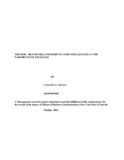| dc.description.abstract | Objective of the study was to establish whether there is a risk - return relationship for companies
operating in the Main Investment Market Segment (MIMS) of the Nairobi Stock Exchange. The
examined Companies in the MIMS are classified into four sectors, viz; Agricultural Sector,
Commercial & Services Sector, Finance & Investment Sector and the Industrial & Allied Sector.
The study was carried out on an exploratory basis to establish whether there exist any differences
in the risk- return patterns of quoted companies in the four sectors of the MIMS market segment
of the NSE. Thirty four (34) companies were selected to comprise the sample of study for the
period January 2005 to December 2009. Historical monthly stock price data was used, translating
into 60 sample months for use in data analysis. Descriptive statistics were used in analysis of
data as most of the data collected is quantitative in nature. The sample mean and standard
deviation of returns was calculated and mean-variance ratios (Sharpe ratios) thereafter computed.
Initial analysis on the sectors riskiness based on standard deviation and beta computations
indicated that the Agricultural sector was the least risky while the Industrial sector was the most
risky. Using Sharpe ratios, the results indicate that Agricultural sector had the highest Sharpe
ratio at 3.756 and thus the most risky among the 4 sectors while Industrial Sector had the lowest
Sharpe ratio of 1.553 and therefore the least risky. To resolve the mixed results, a t-test was
applied with mean variances per sector tested against the market variances. The analysis
concludes that Standard deviations, betas and Sharpe ratios from the 4 sectors of MIMS were not
very much different from the market mean variations during the period under study January
2005-December 2009.
The study showed that there is a link between the sectors in MIMS in which for every period
when one sector is having poor returns, another sector will either benefit immensely or be
adversely affected. However, the difference in returns for the various sectors seems to be
insignificant. This implies that the assumed risks by policy makers might not have existed.
Policy makers should therefore explore other ways of segmenting the NSE Market. | en |

